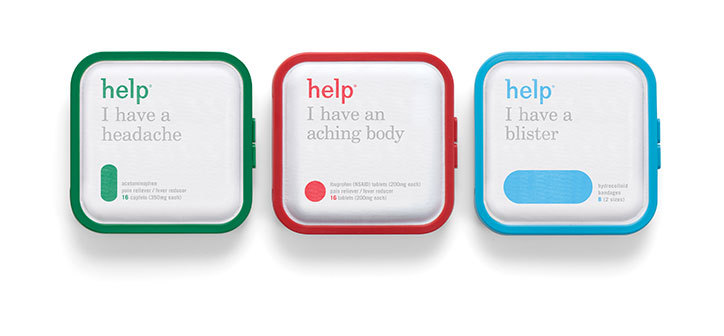Fun vs Function: What makes for better design?
Photo: Xavi Cabrera
I’ve read a lot of articles about the functionality of design — how its purpose is to solve problems as well as to serve as an aesthetic. I resonate with them because at the core of me I believe that good design should always be useful. Despite those that dismiss design as something of a luxury, design is doing a lot of good around us and has a huge impact on the world around us. Good visual communication is essential in order to convey important information effectively, life changing in fact.
Take medicine, for example. The designs needs to be as clear as possible, without distraction. A simple approach is far more effective in order for the information to be easy to understand. But is there scope for designs to be a little less clinical? Is it possible to add a human touch whilst still being clear? Look at ‘Help’ remedies, for example, that convey information effectively by adding humanity to the product and connecting with an emotional and physical need. Rather than just saying the name of the pain relief it shares the problem you’re feeling, already providing relief that the product will solve it for you.
Advertising pamphlet for Medomina, Geigy, c. 1960
Courtesy: Display, Graphic Design Collection (thisisdisplay.org)
Pearlfisher: Help Remedies
Among the Graphic Design projects that solve problems are those that have caught eyes simply because they’re funny or sad — designs that leave people with nothing other than a smile on their face (or perhaps a gimmace). Go to any art gallery and amid the visitors with a good knowledge of art history are those trying to gain understanding, looking at odd shapes and splodges of paint with puzzled looks on their faces. Whether you think a piece of art is meaningless or useless, it still challenges us. What seems nonsensical can raise questions about what we think something is, and even if it seemingly has no meaning we still look for it. We look for meaning in everything — we look for stories.
photo by ROMAN DRITS
The fact is, we buy into emotion all the time. When I pay money to see a comedian I don’t think “well what use is it for her to make me laugh?” I gladly pay for things I find funny: I buy into films that make me cry and I go to exhibitions that leave me with questions, and rarely do I feel short changed.
The problem, though, is that we have learnt to put creativity into two camps: functional design and fun design. We leave the functional stuff for healthcare and science and then the fun stuff for the wacky artists who have probably smoked too much pot. But design that is purely functional often lacks effectiveness — if design is engaging it doubles its usefulness. Of course it may be obvious that this works in education, and many of us can remember using games as a way of learning or song as a way of remembering important information, but we lessen this in adult, assuming that study is only for children.
The Human Body app 2013; artwork by Kelli Anderson for Tinybop
There are many studies that show humour can aid better understanding and retain more information. Emotion has strong ties to the physical — we are doing ourselves a disservice to separate them. As designers, we need to combine functionality and fun more effectively. Perhaps this notion is most obvious in the advertising world , where the best adverts use emotion in order to sell ‘fun’ products and services, but what of more serious issues of conveying vital information? Take the Metro’s ‘Dumb Ways to Die’ campaign in 2012 which used humour to convey the importance of a darker subject – danger at train platforms. By using catchy music and comic cartoons, the information is more likely to be memorable, helping people to be more cautious without making them feel negative.
Dumb ways to die – using humour to convey the importance of safety on train platforms.
In a world of constant notifications and social media scrolling, it’s easy to be overwhelmed by information Our brains need a little help processing it by making information more digestible. Companies now need to evolve to make sure their marketing is simple and engaging. How can we bring more emotion and entertainment into our designs in order to connect with the right customers as well as convey the essential information? Perhaps we too often make the mistake of thinking fun and function are opposing instead of combining them to bring about something altogether more effective.





